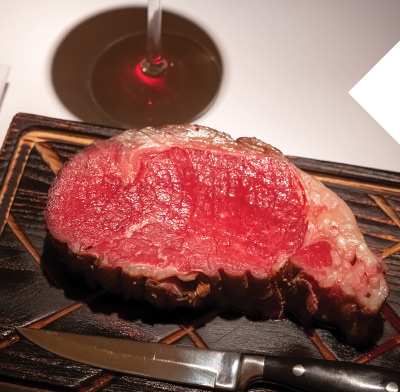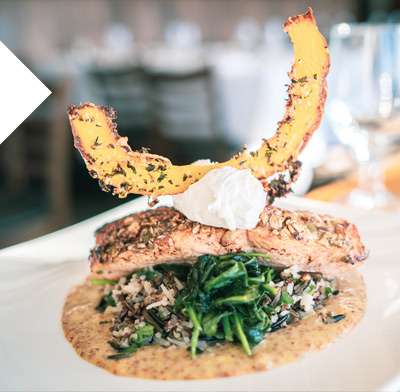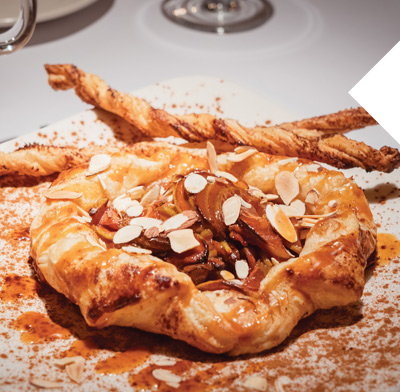My holiday memories are deeply rooted in my mother’s kitchen. From the splendor of a roasted turkey packed with savory giblet stuffing to the freshly baked bourbon pecan pies and Christmas cookies, the days heading up to Christmas were filled with gifts from the kitchen that my mother would proudly display each day. But no culinary Christmas tradition was greater than the great prime rib roast that my dad would carve with his electric knife that was only used for the holiday dinners. Since that time and about 26,000 prime ribs later, I have evolved in my understanding and method of prime rib roasting. This month I am going to share with you all my secrets of roasting the perfect prime rib.
Roche Harbor Founder, Reuben J. Tarte, wanted to bring the amazing prime rib served in the great steak houses of New York City to his newly converted restaurant at The Roche Harbor Inn. Originally the home of land baron John S. McMillin, the restaurant opened Memorial Day of 1958 with a full menu and more importantly, the first establishment in the county to serve spirits.
The menu featured escargot, herring, marinated steaks, seafood, full salad bar, and a prime rib dinner for $8.95. Since that time, we have perfected this recipe and are excited to share it with everyone.
In the interest of rounding out the palate, I also offer a recipe for a pumpkin seed-crusted Chinook salmon to put some of those Halloween-era goodies to use. If your guests have room after the feast, the quick apple pie in a puff pastry recipe makes an ideal seasonal dessert. Enjoy!
 |
Prime RibWhen preparing the best prime rib there are three vital steps that must be followed. First, buy the best prime rib you can find. At Roche Harbor we use USDA Prime grade prime rib that is aged for at least 40 days. Second, cook the roast low and slow. Third, after the prime rib is cooked to the desired temperature, hold it in a warm oven for at least 2 hours. All three of these steps will guarantee a prime rib rich in beef flavor, tender to the bite, and cooked consistently through from end to end. At McMillin’s we cook our prime rib to medium rare or 120 to 125 degrees. Some guests may like their prime rib cooked a little more than medium rare but remember there will be two end cuts that will be more toward the medium side. If a medium prime rib is the goal, cook the prime rib to 125 to 130 degrees.
Directions: Remove the prime rib from the refrigerator 2 hours before it needs to go into the oven. Place the prime rib on the rack of the shallow roasting pan. Rub the entire roast with Lawry’s seasoning salt and freshly cracked black pepper. Let the seasoned prime rib rest on the counter until ready to place in the oven to improve the flavor and tenderness of the prime rib. Open the oven, adjust one of the oven racks to the center position, and remove the rack. Place the standard oven thermometer on the center rack and set the oven temperature to 250 degrees. After the oven is preheated, check the dial on the standard thermometer. It should read 250 degrees. If not, adjust thermostat on oven so that the thermometer reads 250 degrees. Place the prime rib on the roasting rack in the pan and then in the center of the 250-degree oven. Insert the probe of the thermometer into the center of one of the prime rib ends and push the probe deep into roast. Plug the probe into the digital thermometer and adjust to 20 degrees and turn the alarm on. Monitor the thermostat every half hour. When the prime rib’s internal temperature gets to 100 degrees, it will not be long before it reaches 120 degrees. When the prime rib hits the 120 mark, remove from oven and let rest on the counter for 30 minutes. Open the oven door and allow the oven to cool down to 140 degrees. Turn the oven thermostat to 140 degrees. If the oven thermostat does not lower to 140, the oven will have to be turned off and then on again manually to maintain a temperature between 120 and 140 degrees. My oven has this challenge and I have found that if I turn it to 175 degrees for 5 minutes and then turn it off, the 120- to 140-temperature range will last for 30 minutes. Monitor the oven and internal prime rib temperature for the next 2 hours. When ready to serve, place the prime rib, cut side down, on cutting board. At this point, the tail fat must be trimmed before the roast is carved. There is usually a greater proportion of tail fat towards the tail on loin end following the contour of the rib. Trim the fat from the tail, leaving no more than 1½” of tail fat. As a general rule, a 12-ounce. restaurant cut will be 1” thick or the distance between your thumbnail and first joint. Begin by slicing the first end cut and reserve for a guest that prefers medium-cooked meat then continuing slicing, adjusting the thickness of the slice to the amount of prime rib each guest prefers. |
Pumpkin Seed Crusted Chinook SalmonFresh salmon is getting harder to find as we head into the winter months, but troll-caught Chinook are still available from the Gulf of Alaska. If you are unable to find fresh salmon, frozen at sea wild king salmon can be purchased from your seafood monger. Always purchase frozen salmon in its original package in a frozen state. To thaw the filet first cut a slit in the long edge of the packaging, then place on a sheet pan and into your refrigerator to slowly thaw. This will take 18 to 24 hours. The trick with freezing and thawing salmon is to freeze it quickly and thaw it slowly. Never thaw frozen fish in a water bath or at room temperature. This damages the delicate tissue of the fish and forces the natural juices out the fish, resulting in a spongy texture and a loss of flavor.
Directions: In a small bowl, add the goat cheese and fresh whipping cream, then stir with a whisk until the cheese is light and creamy. Set aside for final plating. In a small saucepan over medium heat, add whole grain mustard, orange juice, zest, minced garlic, and wine. Bring ingredients to a simmer and continue cooking until liquid has reduced by 60 percent, about 8 minutes. Add heavy cream and reduce by half, about 4 minutes. Remove pan from heat and whisk small amounts of butter at a time, whisking until the sauce is smooth and thick and all the butter has been added. Season with salt and pepper to taste and hold warm at 120 degrees until plating the salmon. Do not allow the sauce to boil or it will break. Combine the roughly chopped pumpkin seeds and fresh herbs in a small bowl and coat each salmon filet with the seed and herb mixture. Place crusted salmon filets in the center of a warm dinner plate. Ladle orange-mustard sauce around the outside edge of salmon. Using 2 spoons form a quenelle (egg shaped) portion of creamed goat cheese on top of each crusted salmon. Top with crispy squash chip. Serve immediately. |
 |
 |
Quick Apple Pie in Puff PastryI am lucky to know some of the greatest professional mushroom pickers in the foothills of the Cascades and am proud to be on their list of chefs they call when this fruit of the forest rises from the mossy floor of pine needles and decaying conifers. Wild chanterelles, oyster, hen of the woods, bear tooth, porcini, and many more can be found as soon as the rains begin in late September through early November. If you cannot get your hands on any wild mushrooms, most markets have farm-raised oyster, shiitake, and crimini mushrooms that will make a wonderful substitute. Serves 6
Directions: Preheat oven to 350 degrees. In a sauté pan over medium heat melt butter then add sliced and peeled apples. Sauté for 4 minutes stirring to brown apples on all sides. Add brown sugar and cinnamon, continue cooking and stirring until apples are tender to the bite. Strain caramel apple syrup from apples, reserve the syrup and apples and allow to cool. Cut puff pastry into perfect squares and allow to thaw at room temperature. Once the pastry is thawed, place each square on a parchment lined baking sheet. Divide the apples into six equal portions in the center of each puff pastry square. Fold each of the four corners to the center of the square covering the apples but not overlapping. Now fold each corner back to the edge of the pastry, exposing a part of the apple filling. In a small bowl, stir the egg yolk and melted butter to combine. Brush the surface of the puff pastry with the egg mixture. Place in oven and bake until pastry is golden brown and cooked through. Place each little pie on a heated plate and garnish with reserved apple caramel syrup and toasted almonds. Serve with ice cream. |